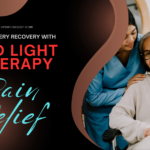
Latest Research in Red Light Therapy: Innovations and Breakthroughs
Introduction
I’ve dealt with skin problems and chronic pain for a long time. The idea of a treatment that’s non-invasive and doesn’t use drugs was exciting to me. That’s why I looked into red light therapy (RLT). It uses light to help cells heal and grow.
RLT started with Dr. Niels Ryberg Finsen in the early 1900s. But NASA’s work in the 1990s really brought it into the spotlight. They found it could help wounds heal and muscles grow, which opened up new possibilities for health and wellness.
Now, RLT is changing fast with new studies and tech. We’re seeing smarter and more portable devices. The future of RLT looks very promising. As you learn more, you’ll see how it could help you.
Image courtesy of NOVAALAB LLC
Key Takeaways
- Red light therapy has its roots in the early 20th century, but gained significant attention through NASA’s research in the 1990s.
- RLT operates in the 600-900 nanometer range to stimulate cellular repair and growth, promoting collagen production and skin rejuvenation.
- Advancements in LED technology and smart integration have led to more efficient and customizable RLT devices for both medical and at-home use.
- Ongoing research is exploring the potential of RLT in treating various medical conditions, including pain management, mental health, and athletic performance enhancement.
- While RLT shows promising results, more comprehensive research is needed to fully understand its overall effectiveness and potential applications.
Evolution of Red Light Therapy
Red light therapy, also known as photobiomodulation (PBM), started with NASA’s research in the 1990s. It has grown into many uses today. This therapy uses light in the red and near-infrared spectrum to heal the skin without harm. The light helps cells repair and grow. This leads to many benefits.
Historical Development from NASA to Modern Applications
NASA first explored using light-emitting diodes (LEDs) for medical purposes. From 1995 to 2003, NASA funded research on LEDs. They wanted to see if LEDs could help wounds heal faster and cells grow. The results were promising. They led to the creation of today’s red light therapy devices.
Scientific Principles Behind Red Light Therapy
Red light therapy works by interacting with the mitochondria in cells. The mitochondria are the cell’s powerhouses. When they absorb the light, they start processes that boost energy, reduce inflammation, and help repair tissues.
How RedLight Therapy Affects Cellular Function
Red and near-infrared light therapy boosts energy in cells. This makes cells work better. It leads to faster healing, less inflammation, more collagen, better skin, and quicker wound healing. The best wavelengths for these benefits are between 600 to 900 nanometers.Expert Video courtesy of NOVAALAB LLC
Latest Research in Red Light Therapy
The field of red light therapy (RLT) is booming with new research. This technology is showing promise in many areas, from skin health to pain relief and mental wellbeing.
Research on skin health is a big part of RLT studies. It shows that RLT boosts collagen, making skin look younger and smoother. It also helps with acne by reducing inflammation and scars.
“Red light therapy has the potential to revolutionize the way we approach skin care and rejuvenation. The research findings are truly remarkable.”
RLT is also good for pain and inflammation. People with arthritis and other joint issues see less pain and better function after RLT. This is a big win for those suffering from chronic pain.
There’s also hope for mental health with RLT. Studies show it can help with depression and anxiety. Plus, it might improve athletic performance and help muscles recover faster.
As Red Light Therapy Research Findings keep coming, the future looks bright. Researchers and healthcare pros are excited to see what more RLT can do. They’re looking forward to unlocking its full potential.
Modern Breakthrough Technologies
The world of red light therapy has seen big changes lately. New tech like smart devices, advanced LEDs, and portable options have changed how we use Innovations in Photobiomodulation and Recent Advances in Red Light Therapy.
Smart Integration and Mobile Applications
Today’s RLT devices are smart and easy to use. You can change settings and control the therapy with your phone. Mobile apps help you plan your treatment, track progress, and get updates in real-time.
Advanced LED Technologies
New LED tech makes light sources better and lasts longer. High-density LEDs cover more area and reach deeper, making treatments more effective. This means you can get the benefits of red light therapy faster and easier.
Portable and Wearable Solutions
Now, you can use RLT devices at home thanks to portable options. There are small devices, belts, wraps, and masks for easy use. Full-body panels give red light to your whole body at once, making treatments better.
These new techs in RLT devices have made therapy better and more accessible. They help with skin, pain, sports, and brain health. As Innovations in Photobiomodulation and Recent Advances in Red Light Therapy keep growing, we’ll see even more ways to improve our health.
Image courtesy of NOVAALAB LLC
Applications and Treatment Benefits
Red light therapy (RLT) is becoming a key treatment option. It’s being studied for many medical and cosmetic uses. This therapy is showing great promise in improving skin health and managing pain.
RLT is especially good for skin issues. Clinical trials show it boosts collagen, reduces wrinkles, and improves skin health. It’s also a promising treatment for acne. It works by reducing sebum, inflammation, and irritation.
RLT is also useful for pain relief. Studies show it can lessen pain in different conditions. This is because it has anti-inflammatory effects and boosts blood vessel formation and cell energy. It’s a non-invasive option for pain management.
RLT’s benefits don’t stop there. It may help with wound healing, psoriasis, and even neurological disorders. It promotes new blood vessel growth, increases collagen, and reduces inflammation. This helps wounds heal faster and supports tissue repair.
The study of Red Light Therapy Clinical Trials is growing. Researchers are finding Breakthroughs in Red Light Therapy. These discoveries could change healthcare and patient care in big ways.
Emerging Therapeutic Applications
The future of red light therapy is full of new and exciting possibilities. Research is showing its potential in supporting mental health, improving athletic performance, and advancing regenerative medicine. These new uses could help many people find non-invasive ways to improve their well-being.
Mental Health and Cognitive Function
Early studies suggest red light therapy may help with depression and anxiety. It’s thought to boost mood by improving cell function and making neurotransmitters. As research grows, it’s looking into how it can help with memory, focus, and brain health.Athletic Performance Enhancement
Athletes are using red light therapy to recover faster, feel less sore, and perform better. Studies show it can heal faster, improve blood flow, and increase strength and endurance. It’s becoming a key tool in sports to enhance performance.
Regenerative Medicine Developments
Red light therapy is also being watched in regenerative medicine. It may help grow stem cells and repair tissues. This could be a game-changer for treating injuries and degenerative diseases. As research continues, its uses in regenerative medicine are expected to grow, offering new hope for healthcare.Image courtesy of NOVAALAB LLC
Frequently Asked Questions
What is red light therapy (RLT)?
Red light therapy (RLT) is a non-invasive treatment. It uses low-level red light to help cells repair and grow. It’s popular in wellness and skincare.
How does red light therapy work?
It works by going through the skin without harm. It boosts energy in cells, leading to better function and healing. It also reduces inflammation and boosts collagen.
What are the benefits of red light therapy?
It helps with anti-aging, pain, and skin health. It improves collagen, reduces wrinkles, and rejuvenates skin. It also helps with pain and inflammation.
How has red light therapy evolved over time?
It started with NASA’s research in the 1990s. Now, it’s more advanced with smart tech and portable devices. This makes it easier to use.
What are the latest research findings on red light therapy?
New studies show it helps with skin, pain, and mental health. It’s also being looked at for sports, regenerative medicine, and heart health.
What are the latest innovations in red light therapy devices?
Devices now have smart tech and better LEDs. They’re also portable and wearable. Full-body panels provide consistent red light.
What are the clinical applications and treatment benefits of red light therapy?
It treats skin issues, reduces wrinkles, and heals wounds. It also manages chronic pain. It shows promise for mental health and neurological disorders.
What are the emerging therapeutic applications of red light therapy?
Research is exploring its use for mental health, cognitive function, and sports. It may also help with stem cell production, tissue regeneration, and heart health.
Additional Information
Additional Sources of Information
- https://prismlightpod.com/recent-innovations-and-the-future-of-red-light-therapy/ – Recent Innovations and the Future of Red Light Therapy
- https://my.clevelandclinic.org/health/articles/22114-red-light-therapy – Red Light Therapy: Benefits, Side Effects & Uses
- https://havenlydecor.com/blogs/red-light-therapy-guides/future-of-red-light-therapy?srsltid=AfmBOoqQ-S-iV6lIE7ibtg1slD5u-jV5TCERCrTCOC3QIzP99HLUh9nY – The Future of Red Light Therapy: Innovations and Emerging Research
- https://www.nsca.com/contentassets/f5974883683c4a348635dd18cb721d4f/nsca-coach-11.1.1-evolution-of-red-and-infrared-light-therapy.pdf?srsltid=AfmBOorqibj3dDnGcDn0P1BzZjYXg1MK_HLAueBSrYsNxiayonL-fKGt – NSCA Coach | Issue 11.1
- https://spinoff.nasa.gov/NASA-Research-Illuminates-Medical-Uses-of-Light – NASA Research Illuminates Medical Uses of Light
- https://www.nature.com/articles/s41433-024-03091-4 – Near infrared/ red light therapy a potential countermeasure for mitochondrial dysfunction in spaceflight associated neuro-ocular syndrome (SANS) – Eye
- https://pmc.ncbi.nlm.nih.gov/articles/PMC3926176/ – A Controlled Trial to Determine the Efficacy of Red and Near-Infrared Light Treatment in Patient Satisfaction, Reduction of Fine Lines, Wrinkles, Skin Roughness, and Intradermal Collagen Density Increase
- https://www.webmd.com/skin-problems-and-treatments/red-light-therapy – What Is Red Light Therapy?
- https://havenlydecor.com/blogs/red-light-therapy-guides/future-of-red-light-therapy?srsltid=AfmBOoqTcZZTg5lGRGvRHJVOHsNF8c8Q3yG1H20ZtRflP_eTt8IggH4Y – The Future of Red Light Therapy: Innovations and Emerging Research
- https://www.theguardian.com/wellness/2024/sep/25/what-is-red-light-therapy – Does red light therapy work? These are the benefits and drawbacks
- https://www.glamour.com/gallery/best-red-light-therapy-devices – After Testing a Bunch of Red Light Therapy Devices—These Are Our Top Picks
- https://www.medicalnewstoday.com/articles/325884 – Red light therapy: Benefits and side effects
- https://www.healthline.com/health/red-light-therapy – Red Light Therapy: Uses, Benefits, and Risks
- https://www.mayoclinic.org/diseases-conditions/seasonal-affective-disorder/in-depth/seasonal-affective-disorder-treatment/art-20048298 – Seasonal affective disorder treatment: Choosing a light box
- https://www.capitolspine.com/red-light-therapy/ – Red Light Therapy – Capitol Spine & Rehabilitation


































Unlock Exclusive Product Insights: Subscribe Now
Join our community of savvy shoppers! Subscribe to our monthly newsletter for expert reviews, top product recommendations, and exclusive deals delivered straight to your inbox. Don’t miss out on discovering the best products on the internet – sign up today and start shopping smarter!
You have Successfully Subscribed!
We promise not to spam you - only quality content to help you discover the best deals on the internet! Absolutely Free.